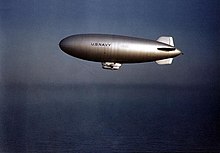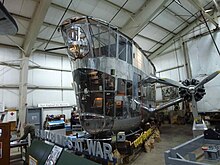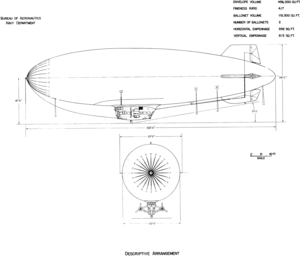K-Class)
Эта статья требует дополнительных цитат для проверки . январь 2010 г. ) |
| К -класс | |
|---|---|
 | |
| Общая информация | |
| Тип | Патрульный дирижабль |
| Производитель | Goodyear-Zeppelin и Goodyear Aircraft Corporation |
| Основной пользователь | ВМС США |
| Номер построен | 134 |
| История | |
| Первый полет | 6 декабря 1938 года |
| Ушедший на пенсию | 1959 |
K -класс Brimps был классом Goodyear (не жесткий дирижабль), построенный в Aircraft Company в Акроне, штат Огайо, для военно -морского флота Соединенных Штатов . Эти дискуссии питались двумя Pratt & Whitney Wasp девятицилиндровыми радиальными воздушными двигателями , каждая из которых установлена на авертигеров с двумя остатками , по одному на сторону управляющего автомобиля, который висел под конвертом . До и во время Второй мировой войны 134 К- были построены и настроены и настраивались тримпы класса для патрулирования и антиловодаренных военных действий, и широко использовались в усилиях по борьбе с военно-морским флотом в районах Атлантического и Тихого океана.
Разработка
[ редактировать ]
В 1937 году K-2 был заказан у Goodyear в рамках контракта, который также купил L-1 (стандартная реклама Goodyear и пассажирский). K -2 производства был прототипом для будущих K покупок дирижабля -класса. К-2 впервые пролетел в Акрон, штат Огайо, 6 декабря 1938 года. [ 1 ] и был доставлен на военно-морской флот в Нэс Лейкхерст , штат Нью-Джерси, 16 декабря. Мощность конверта K- 2-404 000 футов (11 440 м³) была самой большой для любого USN Blimp до того времени. K-2 был широко летать в качестве прототипа и продолжал управлять тестированием нового оборудования, методов и выполнения любых необходимых задач, включая боевые патрули во Второй мировой войне.
24 октября 1940 года военно-морской флот заключил контракт на Goodyear на шесть дирижаблей ( K-3 через K-8 ), которым было назначено назначение Goodyear Znp-K . Эти дискуссии были разработаны для патрульных и сопровождающих обязанностей и были доставлены во флот в конце 1941 года и начале 1942 года. K-3 через K-8 имели лишь незначительные изменения в дизайне K-2 , единственное крупное изменение было в двигателях от Пратта & Whitney R-1340-16 для Райта R-975-28S . Комбинация двигателя/пропеллера Wright оказалась чрезмерно шумной и была заменена в более поздних K-кораблях слегка модифицированными двигателями Pratt & Whitney. K-3 стоил 325 000 долларов. [ 2 ] Последовала серия заказов на большее количество диколетов K-класса. Двадцать один дополнительный диска ( K-9 - K-30 ) были заказаны 14 октября 1942 года. 9 января 1943 года были заказаны еще 21 коляска ( K-31 по K-50 ). Размер оболочки K-9 - K-13 был увеличен до 416 000 футов (11 780 м Мед), а после этого использовались конверт 425 000 футов (12 035 м³). Окончательный контракт на K -класс был присужден в середине 1943 года за 89 дирижаблей. Четыре диска из этого заказа были позже отменены. Оставшиеся поставки были назначены числа K-51 через K-136 . Но число K-136 не было назначено определенным дирижаблям, поскольку управляющий автомобиль, назначенный для K-136, использовался для замены автомобиля для K-113 . Первоначальный автомобиль для K-113 был уничтожен в огне.
Опыт военно-морского флота США с K-корабли в тропических регионах показал необходимость в дирижабе с большим объемом, чем K-класс, чтобы компенсировать потерю подъема из-за высоких температур окружающей среды. Goodyear рассмотрел эти проблемы с последующим дизайном, M-классом , который был на 50% больше.
Варианты
[ редактировать ]После Второй мировой войны ряд k -класса были изменены с помощью более продвинутой электроники, радаров, сонарных систем и более крупными конвертами. Эти модифицированные колючки были назначены:
- ZNP-K
- The original designation of the K-class blimps. Individual blimps were identified by a sequential suffix number, e.g. ZNP-K-2, ZNPK-8 etc. In everyday use only the K and numerical suffixes were used. Batches of blimps were built with sometimes major differences, but the designations remained in the ZNP-K range, until the later versions, listed below, emerged.
- ZPK
- Revised designation of the ZNP-K series.
- ZP2K
- A larger envelope with the volume increased to 527,000 cu ft (14,900 m3), sensors and other improvements re-designated ZSG-2.
- ZP3K
- A larger envelope with the volume increased to 527,000 cu ft (14,900 m3), with systems and controls even more advanced than the ZP2Ks, re-designated ZSG-3.
- ZP4K
- Delivered in 1953, retaining the 527,000 cu ft (14,900 m3) envelope volume and length of 266 ft (81.08 m), re-designated ZSG-4 in 1954.
Operational history
[edit]
The K-ships were used for anti-submarine warfare (ASW) duties in the Atlantic and Pacific Oceans as well as the Mediterranean Sea.[3] All equipment was carried in a forty foot long control car. The installed communications and instrumentation equipment allowed night flying. The blimps were equipped with the ASG radar, that had a detection range of 90 mi (140 km), sonobuoys, and magnetic anomaly detection (MAD) equipment. The K-ships carried four 350 lb (160 kg) depth bombs, two in a bomb bay and two externally, and were equipped with a machine gun in the forward part of the control car. An aircrew of 10 normally operated the K-ships, consisting of a command pilot, two co-pilots, a navigator/pilot, airship rigger, an ordnanceman, two mechanics, and two radiomen.
On 1 June 1944, two K-class blimps of United States Navy (USN) Airship Patrol Squadron 14 (ZP-14)[4] completed the first transatlantic crossing by non-rigid airships.[5] K-123 and K-130 left South Weymouth, MA on 28 May 1944 and flew approximately 16 hours to Naval Station Argentia, Newfoundland. From Argentia, the blimps flew approximately 22 hours to Lajes Field on Terceira Island in the Azores. The final leg of the first transatlantic crossing was about a 20-hour flight from the Azores to Craw Field in Port Lyautey (Kenitra), French Morocco. The first pair of K-ships were followed by K-109 & K-134 and K-112 & K-101 which left South Weymouth on 11 and 27 June 1944, respectively. These six blimps initially conducted nighttime anti-submarine warfare operations to complement the daytime missions flown by FAW-15 aircraft (PBYs and B-24s) using magnetic anomaly detection to locate U-boats in the relatively shallow waters around the Straits of Gibraltar. Later, ZP-14 K-ships conducted minespotting and minesweeping operations in key Mediterranean ports and various escort missions including that of the convoy carrying Franklin Roosevelt and Winston Churchill to the Yalta Conference in early 1945. In late April 1945, K-89 and K-114 left Weeksville NAS in North Carolina and flew a southern transatlantic route to NAS Bermuda, the Azores, and Port Lyautey where they arrived on 1 May 1945 as replacements for Blimp Squadron ZP-14.[6]
The ability of the K-ships to hover and operate at low altitudes and slow speeds resulted in detection of numerous enemy submarines as well as assisting in search and rescue missions. The K-ships had an endurance capability of over 24 hours which was an important factor in the employment of ASW tactics.
The mooring system for the K-ship was a 42 ft (12.8 m) high triangular mooring mast that was capable of being towed by a tractor. For advance bases where moving the mooring mast was not needed, a conventional stick mast was used. A large ground crew was needed to land the blimps and moor them to the mast.
During the war, one K-ship—K-74—was lost to enemy action when it was shot down by U-134 in the Straits of Florida on 18 July 1943. The crew was rescued eight hours later, except for one man who was attacked by a shark and drowned only minutes before the rescue. Five weeks later, U-134 was sunk by a British frigate in the Bay of Biscay on its return voyage to Germany.[7][8]
In 1947, Goodyear acquired the former Navy K-28 and operated it as part of its commercial advertising blimp fleet. The K ship was named Puritan and was the largest ever Goodyear blimp. The airship was purchased from the Navy primarily to experiment with Trans-Lux illuminated running copy advertising signs attached to the envelope. Costly to operate and maintain, The Puritan was retired from the Goodyear fleet in April, 1948 after only one year of operation. The blimp was deflated and placed in storage at Goodyear's base at Wingfoot Lake in Suffield, Ohio and was later sold back to the Navy.
K-43, the last operational Navy "K Ship", was retired from service in March, 1959.
Nuclear weapon effects tests
[edit]
Several K-class blimps were used for nuclear weapon effects tests at the Nevada Test Site (NTS) during the Operation Plumbbob series of tests in 1957. K-40, K-46, K-77 and K-92 were destroyed in Project 5.2, events Franklin (Fissile) and Stokes (19 kt, XW-30 device).[9] The tests were to "determine the response characteristics of the model ZSG-3 airship when subject to a nuclear detonation in order to establish criteria for safe escape distances after airship delivery of antisubmarine warfare special weapons."[10] According to the Navy, the "airship operations were conducted with extreme difficulty."[11] The Navy was trying to determine whether the airship could be among the aircraft to deliver its planned Lulu (W-34) nuclear depth charge.[12]
Airship designations
[edit]During the life of the K-class airship, the U.S. Navy used three different designation systems. From 1922 through World War II, the Navy used a four character designator. The K-class blimps were designated ZNP-K where the "Z" signified lighter-than-air; "N" denoted non-rigid; "P" denoted a patrol mission; and "K" denoted the type or class of airship.
In April 1947, the General Board of the U.S. Navy modified the designation system for airships. The second character of the designator was dropped as the Board dropped the code for rigid airships so that the "N" for non-rigid was no longer needed. The designation for the K-class blimps then became ZPK.
In April 1954, the designation system for lighter-than-air airships was further modified so that it conformed to the designation system for heavier-than-air aircraft. By this time the ZPK blimps had been retired from service and only the later version K-Class blimps were in service. Under the 1954 system the ZP2K blimp became the ZSG-2, the ZP3K became the ZSG-3, the ZP4K became the ZSG-4, and the ZP5K became the ZS2G-1. In new designation system, the "Z" signified lighter-than-air; the "S" was the type denoting an anti-submarine warfare mission; the numeral (i.e., "2") was the model; and the "G" was for Goodyear, the manufacturer's letter in the Navy's designation system. The final numeral denoted the series of the vehicle within the type/model. The US Navy ordered a new type of airship in 1951 for the Korean War. The new air ship was designated ZP4K (later called ZSG-4), which had a different design than WW2 K-type. The first ZP4K was delivered in June 1954. A total of 15 were built. In 1955 an update version a called the ZP5K (later called ZS2G-1) was delivered, a total of 15 were built. The ZP5K has an inverted “Y” tail.[13][14]
Surviving aircraft
[edit]
- K-27 and several other K class blimps were seen in the Metro-Goldwyn-Mayer film This Man's Navy (1945), one of the few motion pictures to depict U.S. Navy blimp operations.
- K-28 - Goodyear Puritan – Control car on static display at the New England Air Museum in Windsor Locks, Connecticut.[15]
- K-47 - Control car on static display at the National Naval Aviation Museum in Pensacola, Florida.[16] The K-47 was upgraded to the ZP3K configuration before it was retired in 1956.[17]
Specifications (K-14)
[edit]
General characteristics
- Crew: 9–10
- Length: 251 ft 8 in (76.73 m)
- Diameter: 57 ft 10 in (17.63 m)
- Volume: 425,000 cu ft (12,043 m3)
- Useful lift: 7,770 lb (3,524 kg)
- Powerplant: 2 × Pratt & Whitney R-1340-AN-2 radials , 425 hp (317 kW) each
Performance
- Maximum speed: 78 mph (125 km/h, 68 kn)
- Cruise speed: 58 mph (93 km/h, 50 kn)
- Range: 2,205 mi (3,537 km, 1,916 nmi)
- Endurance: 38 hours 12 minutes
Armament
- 1 × .50 in (12.7 mm) M2 Browning machine gun
- 4 × 350 lb (160 kg) AN-Mk 47 depth charges
See also
[edit]Related lists
References
[edit]Notes
[edit]- ^ Гроссник, Рой А., изд. (1987). «Preww II Blilmps и эволюция дирижаблей K-Class и WW II» . Воздушные воздушные шары для воздушных кораблей: военно-морской флот легче, чем в эфире . Вашингтон, округ Колумбия: заместитель начальника военно -морских операций (воздушная война) и командир командующего военно -морскими воздушными системами. п. 35
- ^ Crestview, Флорида, «ВМС США получает крупнейший в мире рис», Okaloosa News-Journal , пятница, 31 октября 1941 года, том 27, номер 42, стр. 3.
- ^ André., Baptiste, Fitzroy (1988). Война, сотрудничество и конфликт: европейские владения в Карибском бассейне, 1939–1945 . Нью -Йорк: Greenwood Press. с. 161 . ISBN 9780313254727 Полем OCLC 650310469 .
{{cite book}}: Cs1 maint: несколько имен: список авторов ( ссылка ) - ^ "Эскадрилья Бриза 14" . Архивировано из оригинала на 2009-11-13 . Получено 2010-02-07 .
- ^ «Kaiser, Don, K-Ships по всему Атлантике, Naval Aviation News, Vol. 93 (2), 2011» (PDF) . Архивировано из оригинала (PDF) 2015-02-17 . Получено 2012-07-31 .
- ^ Kline, RC и Kubarych, SJ, Blimpron 14 Overseas, 1944, Военно -морской исторический центр, военно -морской двор, Вашингтон, округ Колумбия
- ^ Вейт, Дж. Гордон «Инцидент во Флоридском проливе» « Труды Военно -морского института Соединенного Штата (август 1979 г.) с.84–86
- ^ Defensemedianetwork.com, Blimp против подводной лодки, Роберт Ф. Дорр - 11 октября 2017 г.
- ^ Оборотное ядерное агентство, серия Plumbob Series 1957 DNA 6005F, Вашингтон, округ Колумбия, страницы 6–7, 41–42, 45, 82
- ^ Оборотное ядерное агентство, серия Plumbob Series 1957 DNA 6005F, Вашингтон, округ Колумбия, стр. 133
- ^ Оборотное ядерное агентство, серия Plumbob Series 1957 DNA 6005F, Вашингтон, округ Колумбия, стр. 133
- ^ Хансен, Чак, Мечи Армагеддона, 1995, Publications Chickelea, Sunnyvale, Калифорния, том VII, стр. 456
- ^ globalsecurity.org Airship
- ^ ИСТОРИЯ.NAVY.MIL, XV. Типы дирижабля в послевоенный период
- ^ «Goodyear Znpk-28 Brince Control Car» . Музей воздуха Новой Англии . Получено 18 февраля 2018 года .
- ^ "K-47 Control Car" . Национальный музей военно -морской авиации . Фонд музея военно -морского авиации . Получено 18 февраля 2018 года .
- ^ Shock, James R., ВМС ВМС США 1915–1962, 2001, Atlantis Productions, Edgewater Florida, ISBN 978-0963974389 , стр. 113
Библиография
[ редактировать ]- Альтофф, Уильям Ф. (1990). Небесные корабли . Нью -Йорк: Орион Книги. ISBN 0-517-56904-3 .
- Альтофф, Уильям Ф. (2009). Забытое оружие: авиабилеты ВМС США и война с подводной лодкой . Аннаполис, доктор медицинских наук: Пресс -военно -морской институт. п. 419. ISBN 978-1-59114-010-8 .
- Шок, Джеймс Р. (2001). Авиабилеты ВМС США 1915–1962 . Эджуотер, Флорида: Атлантис Продакшнс. ISBN 0-9639743-8-6 .
- Руководство пилота пилота военно-морского флота США (PDF) . Акрон, штат Огайо: Goodyear Aircraft Corporation. Сентябрь 1943 года . Получено 22 апреля 2021 года .
- Vaeth, J. Gordon (1992). Brimps и подводные лодки . Аннаполис, Мэриленд: издательство военно -морского института США. ISBN 1-55750-876-3 .
Внешние ссылки
[ редактировать ]| Внешние видео | |
|---|---|